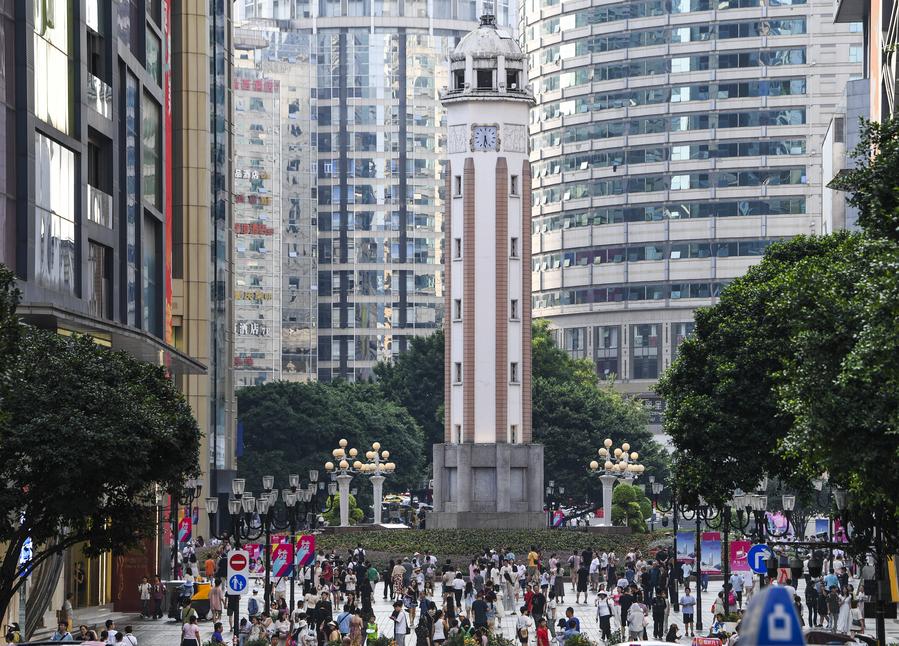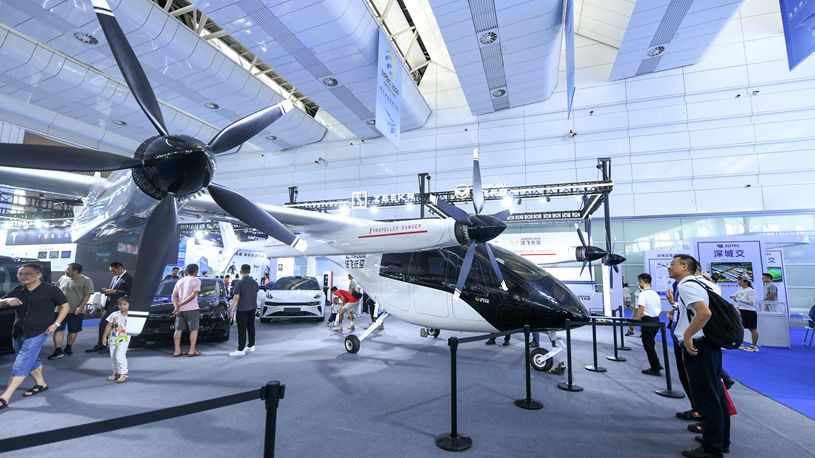Southwest China blends tradition, technology to enhance consumer experience

Tourists visit Jiefangbei, a business area in southwest China's Chongqing, Aug. 21, 2024. (Xinhua/Wang Quanchao)
CHONGQING, Sept. 5 (Xinhua) -- Wandering through the bustling core of southwest China's Chongqing Municipality, one is enveloped by the essence of local culture and the allure of leisure, all the while enhanced by the futuristic interaction of Virtual Reality (VR) that brings history to life.
Nestled within the towering skyscrapers of Yuzhong District, lies a recently revitalized precinct of modern architecture -- the Luzumiao block. Amidst the red-brick and tile-roofed structures, visitors can immerse themselves in the city's storied past while indulging in the eclectic array of shops that promise relaxation and respite.
The Luzumiao block dates back over a century, born when craftsmen gathered to erect a temple in honor of Lu Ban, the revered Chinese artisan, lending the area its name.
Over the decades, it has transformed from a "crafts market" to a "book market," and then to a "flower market," always remaining one of the liveliest arteries in Chongqing.
Since November 2021, a meticulous effort to rejuvenate the district's historic blocks has been underway, focusing on preserving historical significance and architectural features.
This initiative aims to blend the emotional attachment of Chongqing's residents to their heritage with the contemporary aspirations of the younger generation, thus breathing new life into the district's venerable buildings.
Ye Qian, a local resident, revisits a Hong Kong-style tea house named "Uncle" in Luzumiao, sharing, "This was a favorite restaurant of mine 14 years ago. I'm delighted to see it reopen. This street was part of my daily commute during my elementary school days. It now exudes a nostalgic charm with a vibrant new energy."
Jiefangbei, home to Luzumiao, has long symbolized urban prosperity. Amid the high-rise buildings and modern shopping centers, traditional elements had been overshadowed and stagnant.
"Jiefangbei is the embodiment of Chongqing, and we, the younger generation, wish to bring a distinctive flair to this place," said Shu Chang, manager of the Uncle restaurant, who is committed to infusing the old neighborhood with fresh vitality in tandem with the city's rejuvenation.
Beyond the urban renewal that merges tradition with modernity, creating novel consumer experiences, technology also enables immersive historical encounters. When the ancient Chinese mythological classic, "Shan Hai Jing" (Classic of Mountains and Seas), meets cutting-edge technology, it births an enthralling and immersive experience.
Shan Hai Jing, which dates back 2,200 years, gives both a cultural and geographical account of China before the Qin Dynasty. It features geography, folklore, and a wealth of legends and fairy tales, and is often regarded as a primary source of Chinese mythology.
At a shopping center in the city's Jiangbei District, the "Hey! Shan Hai Jing" VR space has become a draw for many families and visitors. With specially designed VR headsets, guests are transported into the mythical world, teeming with legendary creatures and enchanting landscapes.
The VR space, designed by Changjia cultural tourism company, adopts eight state-of-the-art technologies, including real-time rendering, motion capture, eye tracking and spatial audio. Within a 300-square-meter immersive experience zone, visitors can closely observe the 10 major mythical beasts from Shan Hai Jing.
"Such a VR space provides a more immersive experience, replete with interactive elements, which greatly aids children in understanding these stories," said Nie Shujian, a parent who brought his child to the attraction.
Changjia cultural tourism company is actively developing urban digital cultural tourism projects, reimagining well-known historical intellectual properties. In addition to the "Shan Hai Jing" project, it has also developed a project based on its neighboring Sichuan's Sanxingdui site, which attracts some 400 visitors daily.
In July 2021, China approved Shanghai, Beijing, Guangzhou, Tianjin and Chongqing to take the lead in building international consumption center cities.
In recent years, Chongqing has been upgrading its consumer experiences, with innovative business models, a rapid evolution of experiential offerings and a flourishing variety of engaging activities.
From July to August, also a peak season for the local tourism, Chongqing received about 83.2 million visitors, up 15.3 percent year on year. During the period, the tourists spent nearly 90 billion yuan (about 12.68 billion U.S. dollars), up 13.5 percent year on year, according to local authorities.
Photos
Related Stories
- Feature: China's "furnace city" is one of heat and heart
- Feature: Foreign journalists feel modernization in southwest China's mega city
- Nighttime economy remains vibrant in scorching "furnace city"
- Southwest China's Chongqing postpones fall semester due to heatwave
- Chongqing experiences surge in summer tourism
Copyright © 2024 People's Daily Online. All Rights Reserved.









